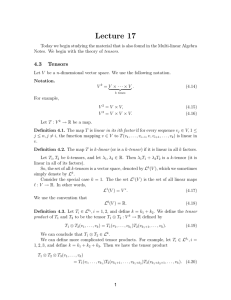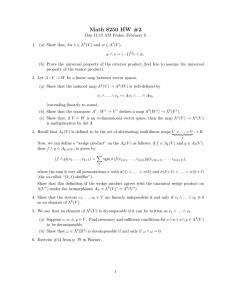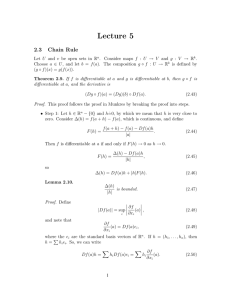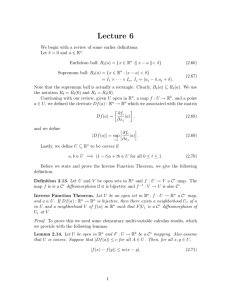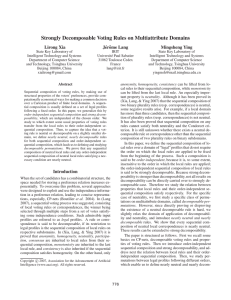Document 13570053
advertisement
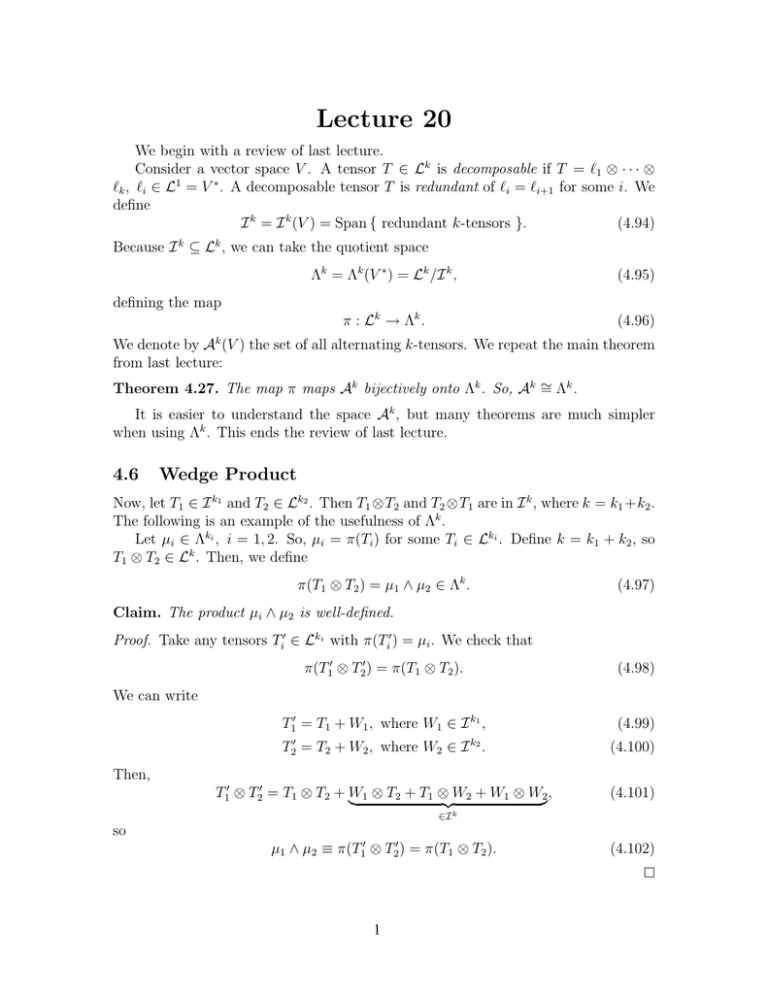
Lecture 20
We begin with a review of last lecture.
Consider a vector space V . A tensor T ∈ Lk is decomposable if T = �
1 ⊗ · · · ⊗
�k , �i ∈ L1 = V ∗ . A decomposable tensor T is redundant of �i = �i+1 for some i. We
define
I k = I k (V ) = Span { redundant k­tensors }.
(4.94)
Because I k ⊆ Lk , we can take the quotient space
Λk = Λk (V ∗ ) = Lk /I k ,
(4.95)
π : Lk → Λk .
(4.96)
defining the map
We denote by Ak (V ) the set of all alternating k­tensors. We repeat the main theorem
from last lecture:
Theorem 4.27. The map π maps Ak bijectively onto Λk . So, Ak ∼
= Λk .
It is easier to understand the space Ak , but many theorems are much simpler
when using Λk . This ends the review of last lecture.
4.6
Wedge Product
Now, let T1 ∈ I k1 and T2 ∈ Lk2 . Then T1 ⊗T2 and T2 ⊗T1 are in I k , where k = k1 +k2 .
The following is an example of the usefulness of Λk .
Let µi ∈ Λki , i = 1, 2. So, µi = π(Ti ) for some Ti ∈ Lki . Define k = k1 + k2 , so
T1 ⊗ T2 ∈ Lk . Then, we define
π(T1 ⊗ T2 ) = µ1 ∧ µ2 ∈ Λk .
(4.97)
Claim. The product µi ∧ µ2 is well­defined.
Proof. Take any tensors Ti� ∈ Lki with π(Ti� ) = µi . We check that
π(T1� ⊗ T2� ) = π(T1 ⊗ T2 ).
(4.98)
We can write
T1� = T1 + W1 , where W1 ∈ I k1 ,
T2�
k2
= T2 + W2 , where W2 ∈ I .
(4.99)
(4.100)
Then,
T1� ⊗ T2� = T1 ⊗ T2 + W1 ⊗ T2 + T1 ⊗ W2 + W1 ⊗ W2 ,
�
��
�
(4.101)
µ1 ∧ µ2 ≡ π(T1� ⊗ T2� ) = π(T1 ⊗ T2 ).
(4.102)
∈I k
so
1
This product (∧) is called the wedge product. We can define higher order wedge
products. Given µi ∈ Λki , i = 1, 2, 3, where µ = π(Ti ), we define
µ1 ∧ µ2 ∧ µ3 = π(T1 ⊗ T2 ⊗ T3 ).
(4.103)
We leave as an exercise to show the following claim.
Claim.
µ1 ∧ µ2 ∧ µ3 = (µ1 ∧ µ2 ) ∧ µ3
= µ1 ∧ (µ2 ∧ µ3 ).
(4.104)
Proof Hint: This triple product law also holds for the tensor product.
We leave as an exercise to show that the two distributive laws hold:
Claim. If k1 = k2 , then
(µ1 + µ2 ) ∧ µ3 = µ1 ∧ µ3 + µ2 ∧ µ3 .
(4.105)
µ1 ∧ (µ2 + µ3 ) = µ1 ∧ µ2 + µ1 ∧ µ3 .
(4.106)
If k2 = k3 , then
Remember that I 1 = {0}, so Λ1 = Λ1 /I 1 = L1 = L1 (V ) = V ∗ . That is,
Λ1 (V ∗ ) = V ∗ .
Definition 4.28. The element µ ∈ Λk is decomposable if it is of the form µ =
�1 ∧ · · · ∧ �k , where each �i ∈ Λ1 = V ∗ .
That means that µ = π(�1 ⊗ · · · ⊗ �k ) is the projection of a decomposable k­tensor.
Take a permutation σ ∈ Sk and an element ω ∈ Λk such that ω = π(T ), where
T ∈ Lk .
Definition 4.29.
ω σ = π(T σ ).
(4.107)
We need to check that this definition does not depend on the choice of T .
Claim. Define ω σ = π(T σ ). Then,
1. The above definition does not depend on the choice of T ,
2. ω σ = (−1)σ ω.
Proof.
1. Last lecture we proved that for T ∈ Lk ,
T σ = (−1)σ T + W,
(4.108)
for some W ∈ I k . Hence, if T ∈ I k , then T σ ∈ I k . If ω = π(T ) = π(T � ), then
T � − T ∈ I k . Thus, (T � )σ − T σ ∈ I k , so ω σ = π((T � )σ ) = π(T σ ).
2
2.
T σ = (−1)σ T + W,
(4.109)
π(T σ ) = (−1)σ π(T ).
(4.110)
ω σ = (−1)σ ω.
(4.111)
for some W ∈ I k , so
That is,
Suppose ω is decomposable, so ω = �1 ∧· · ·∧�k , �i ∈ V ∗ . Then ω = π(�1 ∧· · ·∧�k ),
so
ω σ = π((�1 ⊗ · · · ⊗ �k )σ )
= π(�σ(1) ⊗ · · · ⊗ �σ(k) )
= �σ(1) ∧ · · · ∧ �σ(k) .
(4.112)
�σ(1) ∧ · · · ∧ �σ(k) = (−1)σ �1 ∧ · · · ∧ �k .
(4.113)
Using the previous claim,
For example, if k = 2, then σ = τ1,2 . So, �2 ∧ �1 = −�1 ∧ �2 . In the case k = 3, we
find that
(�1 ∧ �2 ) ∧ �3 = �1 ∧ (�2 ∧ �3 )
= −�1 ∧ (�3 ∧ �2 ) = −(�1 ∧ �3 ) ∧ �2
= �3 ∧ (�1 ∧ �2 ).
(4.114)
This motivates the following claim, the proof of which we leave as an exercise.
Claim. If µ ∈ Λ2 and � ∈ Λ1 , then
µ ∧ � = � ∧ µ.
(4.115)
Proof Hint: Write out µ as a linear combination of decomposable elements of Λ2 .
Now, suppose k = 4. Moving �3 and �4 the same distance, we find that
(�1 ∧ �2 ) ∧ (�3 ∧ �4 ) = (�3 ∧ �4 ) ∧ (�1 ∧ �2 ).
(4.116)
The proof of the following is an exercise.
Claim. If µ ∈ Λ2 and ν ∈ Λ2 , then
µ ∧ ν = ν ∧ µ.
We generalize the above claims in the following:
3
(4.117)
Claim. Left µ ∈ Λk and ν ∈ Λ� . Then
µ ∧ ν = (−1)k� ν ∧ µ.
(4.118)
Proof Hint: First assume k is even, and write out µ as a product of elements all of
degree two. Second, assume that k is odd.
Now we try to find a basis for Λk (V ∗ ). We begin with
e1 , . . . , en a basis of V ,
e∗1 , . . . , e∗n a basis of V ∗ ,
(4.119)
(4.120)
e∗I = e∗i1 ⊗ · · · ⊗ e∗ik , I = (i1 , . . . , ik ), 1 ≤ ir ≤ n, a basis of Lk ,
ψI =
Alt (e∗I ),
k
I’s strictly increasing, a basis of A (V ).
(4.121)
(4.122)
We know that π maps Ak bijectively onto Λk , so π(ψI ), where I is strictly increasing,
are a basis of Λk (V ∗ ).
�
ψI = Alt e∗I =
(−1)σ (e∗I )σ .
(4.123)
So,
π(ψI ) =
�
(−1)σ π((e∗I )σ )
=
�
(−1)σ (−1)σ π(e∗I )
(4.124)
k!π(e∗I )
=
≡ k!ẽI .
Theorem 4.30. The elements of Λk (V ∗ )
ẽ∗i1 ∧ · · · ∧ e˜∗ik , 1 ≤ i1 < . . . < ik ≤ n
(4.125)
are a basis of Λk (V ∗ ).
Proof. The proof is above.
Let V, W be vector spaces, and let A : V → W be a linear map. We previously
defined the pullback operator A∗ : Lk (W ) → Lk (V ). Also, given Ti ∈ Lki (W ), i =
1, 2, we showed that A∗ (T1 ⊗ T2 ) = A∗ T1 ⊗ A∗ T2 . So, if T = �1 ⊗ · · · ⊗ �k ∈ Lk (W ) is
decomposable, then
A∗ T = A∗ �1 ⊗ · · · ⊗ A∗ �k , �i ∈ W ∗ .
(4.126)
If �i = �i+1 , then A∗ �1 = A∗ �i+1 . This shows that if �1 ⊗ · · · ⊗ �k is redundant, then
A∗ (�1 ⊗ · · · ⊗ �k ) is also redundant. So,
A∗ I k (W ) ⊆ I k (V ).
(4.127)
Let µ ∈ Λk (W ∗ ), so µ = π(T ) for some T ∈ Lk (W ). We can pullback to get
π(A∗ T ) ∈ Λk (V ∗ ).
4
Definition 4.31. A∗ µ = π(A∗ T ).
This definition makes sense. If µ = π(T ) = π(T � ), then T � − T ∈ I k (W ). So
A∗ T � − A∗ T ∈ I k (V ), which shows that A∗ µ = π(A∗ T � ) = π(A∗ T ).
We ask in the homework for you to show that the pullback operation is linear and
that
A∗ (µ1 ∧ µ2 ) = A∗ µ1 ∧ A∗ µ2 .
(4.128)
5



